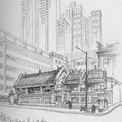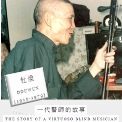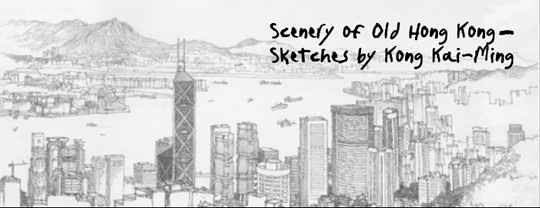Pingsha Luoyan (Wild Geese Landing on Sand)
The piece first appeared in a manuscript of the late Ming Dynasty. One of the most widely played pieces of the last three hundred years, it exists in scores of notational versions. The version in the Tianwenge Qinpu (Tianwenge Qin Handbook) (1876) has a note that suggests programmatic content: “The autumnal sky is high and the air is clear; the wind is calm and the sand is smooth; the clouds stretch for ten thousand miles; the wild geese fly freely in the sky, sharing the thoughts of this wanderer.” This recording is played based on the score handed down by Pei Jieqing and is played by Ho Chun-wah, Johannes with his own made Shennong Style Qin (silk strings).| Date | 2013 |
| Maker's Note | Passing Wang Toi Shan in Shap Pat Heung, Yuen Long, I spied a pile of wood beams that had been recently removed from an old house stacked by the road side. One of them appeared to be the fir main beam which I thought would be good enough for making qin. I immediately asked my friends in the district to liaise with the locals and acquired the beam. The beam was then taken to Hong Kong’s last fir sawmill in Ngau Tam Mei. Master Choi Chang-sau was invited to supervise the sawing and the wood was cut into a few pieces. This qin was created from one of the pieces hewn that day. At the time of making this qin, a Shennong style qin known as Yichibo was being auctioned in the mainland. I was inspired by its simple and smooth shape and rounded elegance. I asked Master Choi for the paper pattern and created this qin based on it. |
| People | Ho Chun-wah, Johannes |
| Material Type | Audio |
| Collection | The Legend of Silk and Wood: A Hong Kong Qin Story |
| Source | Intangible Cultural Heritage Office and Hong Kong Heritage Museum |
| Repository | Intangible Cultural Heritage Office |
| Note to Copyright | Permission for use in Hong Kong Memory is given by Intangible Cultural Heritage Office and Hong Kong Heritage Museum |
| Accession No. | lcs-hkqs-0224 |


Wuye Wu Qiufeng (Parasol Leaves Dancing in the Autumn Breeze)
This piece first appeared in the Qinxue Xinsheng (Study and Aspirations of the Qin) (1664) by Zhuang Zhenfung of the Qing Dynasty and is the most widely played piece among the composer’s fourteen works. It has a delicate melody which evocatively describes the sound of falling leaves in an autumn breeze. In this performance, the piece is played based on Qing Rui's heirloom manuscripts and is played by Yung Hak-chi, Hammond with his own made Keng'er Qin (metal strings).


Yangguan Sandie (Parting at Yangguan)
The earliest version of this piece of qin music appeared in the Zheyin Shizi Qinpu (Qin Songs in Zhejiang Dialect) (1491). The lyrics were developed from a famous poem by the Tang poet, Wang Wei, titled Song Yuan’er Shi Anxi (Seeing Yuan Er Off as Commissioner to Anxi). Many other versions appeared later, but these were either shortened or extended as the arrangers or musicians saw fit. This version is derived from the Yinyinshi Qinpu (Yinyinshi Manuscript) (2000) of Tsar Teh-yun. The music opens slowly, and then accelerates. As the emotions escalate, it changes to rubato before it comes to a more relaxed and muted closing, ending on harmonic notes. The undulating melodic line attempts to recreate the changing emotions of dear friends at parting. This recording is played by Ng Ying-wai with her own made Songtao Qin (synthetic fibre strings).


Pingsha Luoyan (Wild Geese Landing on Sand)
This piece first appeared in a manuscript of the late Ming Dynasty. One of the most widely played pieces of the last three hundred years, it exists in scores of notational versions. The version in the Tianwenge Qinpu (Tianwenge Qin Handbook) (1876) bears a note that suggests programmatic content: “The autumnal sky is high and the air is clear; the wind is calm and the sand is smooth; the clouds stretch for ten thousand miles; the wild geese fly freely in the sky, sharing the thoughts of this wanderer.” This recording is played based on Jiao’an Qinpu (Jiao’an Qin Handbook) (1868) and is played by Siu Yat-tung with his own made Zhongni Style Qin (silk strings).
Pingsha Luoyan (Wild Geese Landing on Sand)
The piece first appeared in a manuscript of the late Ming Dynasty. One of the most widely played pieces of the last three hundred years, it exists in scores of notational versions. The version in the Tianwenge Qinpu (Tianwenge Qin Handbook) (1876) has a note that suggests programmatic content: “The autumnal sky is high and the air is clear; the wind is calm and the sand is smooth; the clouds stretch for ten thousand miles; the wild geese fly freely in the sky, sharing the thoughts of this wanderer.” This recording is played based on the score handed down by Pei Jieqing and is played by Ho Chun-wah, Johannes with his own made Shennong Style Qin (silk strings).| Date | 2013 |
| Material Type | Audio |
| People | Ho Chun-wah, Johannes |
| Collection | The Legend of Silk and Wood: A Hong Kong Qin Story |
| Source | Intangible Cultural Heritage Office and Hong Kong Heritage Museum |
| Repository | Intangible Cultural Heritage Office |
| Note to Copyright | Permission for use in Hong Kong Memory is given by Intangible Cultural Heritage Office and Hong Kong Heritage Museum |
| Accession No. | lcs-hkqs-0224 |


Wuye Wu Qiufeng (Parasol Leaves Dancing in the Autumn Breeze)
This piece first appeared in the Qinxue Xinsheng (Study and Aspirations of the Qin) (1664) by Zhuang Zhenfung of the Qing Dynasty and is the most widely played piece among the composer’s fourteen works. It has a delicate melody which evocatively describes the sound of falling leaves in an autumn breeze. In this performance, the piece is played based on Qing Rui's heirloom manuscripts and is played by Yung Hak-chi, Hammond with his own made Keng'er Qin (metal strings).


Yangguan Sandie (Parting at Yangguan)
The earliest version of this piece of qin music appeared in the Zheyin Shizi Qinpu (Qin Songs in Zhejiang Dialect) (1491). The lyrics were developed from a famous poem by the Tang poet, Wang Wei, titled Song Yuan’er Shi Anxi (Seeing Yuan Er Off as Commissioner to Anxi). Many other versions appeared later, but these were either shortened or extended as the arrangers or musicians saw fit. This version is derived from the Yinyinshi Qinpu (Yinyinshi Manuscript) (2000) of Tsar Teh-yun. The music opens slowly, and then accelerates. As the emotions escalate, it changes to rubato before it comes to a more relaxed and muted closing, ending on harmonic notes. The undulating melodic line attempts to recreate the changing emotions of dear friends at parting. This recording is played by Ng Ying-wai with her own made Songtao Qin (synthetic fibre strings).


Pingsha Luoyan (Wild Geese Landing on Sand)
This piece first appeared in a manuscript of the late Ming Dynasty. One of the most widely played pieces of the last three hundred years, it exists in scores of notational versions. The version in the Tianwenge Qinpu (Tianwenge Qin Handbook) (1876) bears a note that suggests programmatic content: “The autumnal sky is high and the air is clear; the wind is calm and the sand is smooth; the clouds stretch for ten thousand miles; the wild geese fly freely in the sky, sharing the thoughts of this wanderer.” This recording is played based on Jiao’an Qinpu (Jiao’an Qin Handbook) (1868) and is played by Siu Yat-tung with his own made Zhongni Style Qin (silk strings).
Pingsha Luoyan (Wild Geese Landing on Sand)
The piece first appeared in a manuscript of the late Ming Dynasty. One of the most widely played pieces of the last three hundred years, it exists in scores of notational versions. The version in the Tianwenge Qinpu (Tianwenge Qin Handbook) (1876) has a note that suggests programmatic content: “The autumnal sky is high and the air is clear; the wind is calm and the sand is smooth; the clouds stretch for ten thousand miles; the wild geese fly freely in the sky, sharing the thoughts of this wanderer.” This recording is played based on the score handed down by Pei Jieqing and is played by Ho Chun-wah, Johannes with his own made Shennong Style Qin (silk strings).| Date | 2013 |
| People | Ho Chun-wah, Johannes |
| Material Type | Audio |
| Collection | The Legend of Silk and Wood: A Hong Kong Qin Story |
| Source | Intangible Cultural Heritage Office and Hong Kong Heritage Museum |
| Repository | Intangible Cultural Heritage Office |
| Note to Copyright | Permission for use in Hong Kong Memory is given by Intangible Cultural Heritage Office and Hong Kong Heritage Museum |
| Accession No. | lcs-hkqs-0224 |


Wuye Wu Qiufeng (Parasol Leaves Dancing in the Autumn Breeze)
This piece first appeared in the Qinxue Xinsheng (Study and Aspirations of the Qin) (1664) by Zhuang Zhenfung of the Qing Dynasty and is the most widely played piece among the composer’s fourteen works. It has a delicate melody which evocatively describes the sound of falling leaves in an autumn breeze. In this performance, the piece is played based on Qing Rui's heirloom manuscripts and is played by Yung Hak-chi, Hammond with his own made Keng'er Qin (metal strings).


Yangguan Sandie (Parting at Yangguan)
The earliest version of this piece of qin music appeared in the Zheyin Shizi Qinpu (Qin Songs in Zhejiang Dialect) (1491). The lyrics were developed from a famous poem by the Tang poet, Wang Wei, titled Song Yuan’er Shi Anxi (Seeing Yuan Er Off as Commissioner to Anxi). Many other versions appeared later, but these were either shortened or extended as the arrangers or musicians saw fit. This version is derived from the Yinyinshi Qinpu (Yinyinshi Manuscript) (2000) of Tsar Teh-yun. The music opens slowly, and then accelerates. As the emotions escalate, it changes to rubato before it comes to a more relaxed and muted closing, ending on harmonic notes. The undulating melodic line attempts to recreate the changing emotions of dear friends at parting. This recording is played by Ng Ying-wai with her own made Songtao Qin (synthetic fibre strings).


Pingsha Luoyan (Wild Geese Landing on Sand)
This piece first appeared in a manuscript of the late Ming Dynasty. One of the most widely played pieces of the last three hundred years, it exists in scores of notational versions. The version in the Tianwenge Qinpu (Tianwenge Qin Handbook) (1876) bears a note that suggests programmatic content: “The autumnal sky is high and the air is clear; the wind is calm and the sand is smooth; the clouds stretch for ten thousand miles; the wild geese fly freely in the sky, sharing the thoughts of this wanderer.” This recording is played based on Jiao’an Qinpu (Jiao’an Qin Handbook) (1868) and is played by Siu Yat-tung with his own made Zhongni Style Qin (silk strings).
Pingsha Luoyan (Wild Geese Landing on Sand)
The piece first appeared in a manuscript of the late Ming Dynasty. One of the most widely played pieces of the last three hundred years, it exists in scores of notational versions. The version in the Tianwenge Qinpu (Tianwenge Qin Handbook) (1876) has a note that suggests programmatic content: “The autumnal sky is high and the air is clear; the wind is calm and the sand is smooth; the clouds stretch for ten thousand miles; the wild geese fly freely in the sky, sharing the thoughts of this wanderer.” This recording is played based on the score handed down by Pei Jieqing and is played by Ho Chun-wah, Johannes with his own made Shennong Style Qin (silk strings).| Interview Date | Date | 2013 |
| People | Ho Chun-wah, Johannes | |
| Material Type | Audio | |
| Collection | The Legend of Silk and Wood: A Hong Kong Qin Story | |
| Source | Intangible Cultural Heritage Office and Hong Kong Heritage Museum | |
| Repository | Intangible Cultural Heritage Office | |
| Note to Copyright | Permission for use in Hong Kong Memory is given by Intangible Cultural Heritage Office and Hong Kong Heritage Museum | |
| Accession No. | lcs-hkqs-0224 |


Wuye Wu Qiufeng (Parasol Leaves Dancing in the Autumn Breeze)
This piece first appeared in the Qinxue Xinsheng (Study and Aspirations of the Qin) (1664) by Zhuang Zhenfung of the Qing Dynasty and is the most widely played piece among the composer’s fourteen works. It has a delicate melody which evocatively describes the sound of falling leaves in an autumn breeze. In this performance, the piece is played based on Qing Rui's heirloom manuscripts and is played by Yung Hak-chi, Hammond with his own made Keng'er Qin (metal strings).


Yangguan Sandie (Parting at Yangguan)
The earliest version of this piece of qin music appeared in the Zheyin Shizi Qinpu (Qin Songs in Zhejiang Dialect) (1491). The lyrics were developed from a famous poem by the Tang poet, Wang Wei, titled Song Yuan’er Shi Anxi (Seeing Yuan Er Off as Commissioner to Anxi). Many other versions appeared later, but these were either shortened or extended as the arrangers or musicians saw fit. This version is derived from the Yinyinshi Qinpu (Yinyinshi Manuscript) (2000) of Tsar Teh-yun. The music opens slowly, and then accelerates. As the emotions escalate, it changes to rubato before it comes to a more relaxed and muted closing, ending on harmonic notes. The undulating melodic line attempts to recreate the changing emotions of dear friends at parting. This recording is played by Ng Ying-wai with her own made Songtao Qin (synthetic fibre strings).


Pingsha Luoyan (Wild Geese Landing on Sand)
This piece first appeared in a manuscript of the late Ming Dynasty. One of the most widely played pieces of the last three hundred years, it exists in scores of notational versions. The version in the Tianwenge Qinpu (Tianwenge Qin Handbook) (1876) bears a note that suggests programmatic content: “The autumnal sky is high and the air is clear; the wind is calm and the sand is smooth; the clouds stretch for ten thousand miles; the wild geese fly freely in the sky, sharing the thoughts of this wanderer.” This recording is played based on Jiao’an Qinpu (Jiao’an Qin Handbook) (1868) and is played by Siu Yat-tung with his own made Zhongni Style Qin (silk strings).
Pingsha Luoyan (Wild Geese Landing on Sand)
The piece first appeared in a manuscript of the late Ming Dynasty. One of the most widely played pieces of the last three hundred years, it exists in scores of notational versions. The version in the Tianwenge Qinpu (Tianwenge Qin Handbook) (1876) has a note that suggests programmatic content: “The autumnal sky is high and the air is clear; the wind is calm and the sand is smooth; the clouds stretch for ten thousand miles; the wild geese fly freely in the sky, sharing the thoughts of this wanderer.” This recording is played based on the score handed down by Pei Jieqing and is played by Ho Chun-wah, Johannes with his own made Shennong Style Qin (silk strings).| Interviewee | Ho Chun-wah, Johannes |
| Date | 2013 |
| Material Type | Audio |
| Collection | The Legend of Silk and Wood: A Hong Kong Qin Story |
| Source | Intangible Cultural Heritage Office and Hong Kong Heritage Museum |
| Repository | Intangible Cultural Heritage Office |
| Note to Copyright | Permission for use in Hong Kong Memory is given by Intangible Cultural Heritage Office and Hong Kong Heritage Museum |
| Accession No. | lcs-hkqs-0224 |


Wuye Wu Qiufeng (Parasol Leaves Dancing in the Autumn Breeze)
This piece first appeared in the Qinxue Xinsheng (Study and Aspirations of the Qin) (1664) by Zhuang Zhenfung of the Qing Dynasty and is the most widely played piece among the composer’s fourteen works. It has a delicate melody which evocatively describes the sound of falling leaves in an autumn breeze. In this performance, the piece is played based on Qing Rui's heirloom manuscripts and is played by Yung Hak-chi, Hammond with his own made Keng'er Qin (metal strings).


Yangguan Sandie (Parting at Yangguan)
The earliest version of this piece of qin music appeared in the Zheyin Shizi Qinpu (Qin Songs in Zhejiang Dialect) (1491). The lyrics were developed from a famous poem by the Tang poet, Wang Wei, titled Song Yuan’er Shi Anxi (Seeing Yuan Er Off as Commissioner to Anxi). Many other versions appeared later, but these were either shortened or extended as the arrangers or musicians saw fit. This version is derived from the Yinyinshi Qinpu (Yinyinshi Manuscript) (2000) of Tsar Teh-yun. The music opens slowly, and then accelerates. As the emotions escalate, it changes to rubato before it comes to a more relaxed and muted closing, ending on harmonic notes. The undulating melodic line attempts to recreate the changing emotions of dear friends at parting. This recording is played by Ng Ying-wai with her own made Songtao Qin (synthetic fibre strings).


Pingsha Luoyan (Wild Geese Landing on Sand)
This piece first appeared in a manuscript of the late Ming Dynasty. One of the most widely played pieces of the last three hundred years, it exists in scores of notational versions. The version in the Tianwenge Qinpu (Tianwenge Qin Handbook) (1876) bears a note that suggests programmatic content: “The autumnal sky is high and the air is clear; the wind is calm and the sand is smooth; the clouds stretch for ten thousand miles; the wild geese fly freely in the sky, sharing the thoughts of this wanderer.” This recording is played based on Jiao’an Qinpu (Jiao’an Qin Handbook) (1868) and is played by Siu Yat-tung with his own made Zhongni Style Qin (silk strings).








